In 1977, a group of scientists ventured to the bottom of the Pacific Ocean off the coast of Ecuador. What they discovered fundamentally changed our understanding of life on Earth.
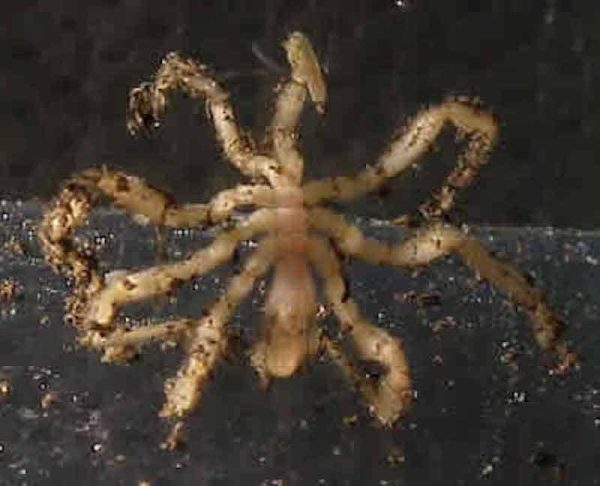
Imagine you receive a call from the National Geographic Society informing you that you’ve been selected to take a trip to the most exotic and unusual place on earth, all expenses paid…AND you get to choose the destination.
Where would you go? How about:
- The deepest, darkest, part of the Amazon Rain Forest, where you can find a boiling river, walking trees, and the largest spider in the world.
- The Blood Falls in Antarctica, home of an ancient community of microbes, described as “primordial ooze,” that survives without light or oxygen.
- The Canaima National Park in Venezuela, a world heritage site where 29 species of birds and one third of the plants are found nowhere else on Earth.
These are all extreme environments with unusual creatures large and small, but if I were the lucky recipient, I would head straight for the nearest oceanographic research vessel I could find and sail to the Endeavour Hydrothermal Vents off the coasts of Washington State and Canada. It would take a while to get there, given it is located hundreds of miles from land and, yes, I would need some fancy equipment to descend over a mile to the bottom of the ocean. But once I got there, I would see something out of a science fiction movie: multicolored, superheated plumes of water rising from the seafloor like smoke; a jagged landscape of valleys, ridges, spires and chimneys; bright orange worms 10 feet long; giant clams and weird sea spiders. There’s an amazing, surreal landscape down there filled with a strange collection of inhabitants that do just fine without the light of the sun.
A “Titanic” Discovery
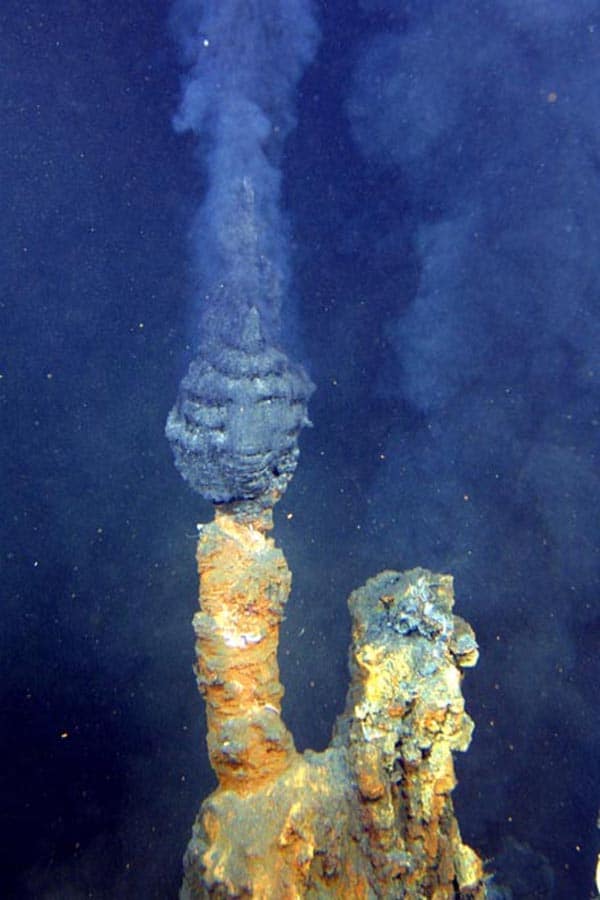
Beginning in the mid-1960s around the time the USA was frantically trying to get into outer space and walk on the moon, another group of explorers was studying the inner space at the bottom of the ocean. They were looking for heat.
In some parts of the ocean, scientists had encountered an unusual phenomenon: warm water at the bottom of the sea where really cold water ought to be. The cause of this was uncertain, but studies in the Red Sea (actually considered to be a young ocean) suggested that the warm-water patterns coincided with fractured areas of the sea floor. These fractures, called vents, were believed to be caused by plate tectonics–the movement of large masses of the Earth’s crust, something that has been going on for billions of years. We’re periodically reminded of them during earthquakes and tsunamis.
More clues emerged when scientists collected samples of the seafloor in the vicinity of the warm areas and found uncharacteristically high levels of copper, iron, and manganese, suggesting that material was being deposited there from deep inside the earth. The Red Sea investigations got a lot of people interested in deep-ocean vent studies and prompted explorations at other locations in the world where unusual ocean water temperatures were found in geologically active areas.
It was the oceanographic equivalent of a moonshot.
Another area of interest called the Galapagos Rift off the coast of Ecuador, north of the Galapagos Islands, became the focus of scientists from Scripps Institution of Oceanography. The Scripps folks made a series of voyages to the area in the late 1960s and early 1970s, during which they deployed a variety of instruments to detect and track the warm-water plumes and search for evidence of undersea earthquakes likely to be present in vent areas. All the evidence pointed to sea floor vent releases of superheated water carrying metals and other elements from inner earth, but no one so far had ever seen an actual vent.
That changed in 1976 when the Scripps scientists went back to the Galapagos Rift for another look and deployed “Deep Tow,” an aptly named towed underwater sensor platform that glided just above the ocean bottom. This time they hit pay dirt. In addition to finding evidence of warm water rising nearly 40 meters from a fracture in the ocean floor, photographs from Deep Tow showed rocks covered with white and yellow crusty material, some empty clamshells, and according to legend, a beer can.
And just like that, the Galapagos Rift became ground zero in the search for deep vents. Soon after, somebody you might have heard of showed up.
On February 12, 1977, the RV Knorr arrived at the Galapagos Rift carrying a team of scientists from the Woods Hole Oceanographic Institute to have another crack at the cracks. The expedition leaders were Richard Von Herzen and a guy named Robert Ballard, best known for finding the Titanic in 1985. After scouting around for a few days using an unmanned vehicle called ANGUS, they found a “hot spot” and obtained photographic evidence of vent activity and more clam shells (but, thankfully, no beer cans).
It was time to send somebody down there, and they had just the vehicle for doing that: the submersible ALVIN. On February 17, the three-man ALVIN crew reached the bottom, looked out the portal, and saw with their own eyes an active hydrothermal vent. Here’s what Bob Ballard had to say about it later on:
Then they saw something else they were totally not expecting: living, breathing, biological life, and lots of it! Right there in the midst of lava beds and oceanic vents discharging scalding water and nasty inorganic chemicals. Had there been any biologists aboard the Knorr, they would have rejoiced at this discovery. However, no one expected to find any actual life down there, and so the crew was mostly geologists. Pressed into service as substitute biologists, they did their best to collect and preserve samples of what they had discovered. Some were put in formaldehyde (including a giant wormlike thing), and when the formaldehyde ran out, the remainder were preserved in vodka (I’m not questioning why they had vodka out there, I’m just thankful they did). Some of those samples are now exhibited at the Smithsonian Institution in Washington D.C.
A National Public Radio story in 2011 summed up the importance of one of the samples:
Today, the Smithsonian Institution houses that remarkable discovery: a pale and fleshy, 4-foot-long worm that floats in the kind of pickle jar you’d see in your neighborhood delicatessen. It might not look like much now, but Kristian Fauchald, the Smithsonian’s curator of worms, says that in 1977, this worm had everyone scratching their heads. At up to 7 feet in length, he says, “these are enormous beasts compared to normal worms.” And they were thriving in large numbers without any obvious source of food or light. “This,” Fauchald says, holding up the worm, “is something absolutely unique.”
In the spring of 1979, the first biologists finally made it to the Galapagos site and were stunned by what they saw. In addition to the giant tube worms and clams, there were blind crab, siphonophores, and even an octopus. As the exploration continued, some of the sites were given descriptive names like “Garden of Eden,” “Dandelion Patch,” “Clambake 2,” and “Oyster Bed.” As you will see below, the discoveries have profoundly affected our theories of life on earth and may aid us in discovering life on other worlds.
Although hundreds of vent sites have been discovered throughout the world since then, it is important to remember what happened on February 17, 1977, because that’s the day the study of biological science on earth was changed forever.
Hydrothermal Vent Dynamics
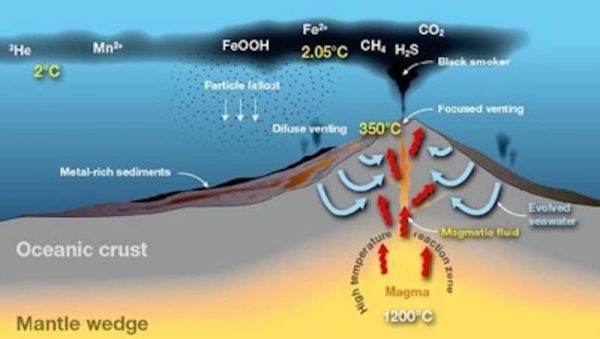
Since the discoveries at the Galapagos Rift, scientists have learned a lot about how hydrothermal vents operate and the influence they exert both locally and globally, on the oceans of the world. As you can see from the diagram above, the basic processes at work involve seawater infiltrating the oceanic crust and encountering rising magma. As it travels upward through the crust, the superheated water dissolves crustal minerals. When it’s discharged into the overlying seawater, it rapidly cools and creates deposits on the ocean floor, providing the raw materials for life and also the material that forms the chimneys and towers that can grow to heights of over 100 feet in some places. The vent inhabitants live in a narrow “Goldilocks zone” where the temperatures are suitable for life. A short distance away from the vents, animal abundances dramatically decrease. Microbial inhabitants can exist at temperatures over 100C (212F), the temperature at which water boils at sea level.
Given the nature of their creation and destruction via tectonic plate shifts, vents have come and gone for billions of years. They are often found in very localized areas on the ocean floor. At the Endeavour Hydrothermal Vents off the coasts of Washington and Canada, for instance, there are 5 major vent fields within a distance of only 15km (~9 miles). All five are in various stages of evolution, meaning some are relatively young, while others, characterized by chimneys that can tower 50 feet above the seascape, are much older. In some places, older towers and chimneys have toppled over, disturbing the life associated with them. One of them, called “Godzilla,” was estimated to be 150 feet tall before it crumbled in 1995.
It’s important to note that all of these processes are occurring at depths and pressures that would crush an unprotected human being and at temperatures hotter than those reached in a commercial autoclave used to sterilize medical equipment. In addition, the water and sediments in the vicinity of the vents can contain concentrations of heavy metals and sulfides that would be toxic to most marine and terrestrial life.
As you will soon see, the humble star in these amazing ecosystems is a collection of single-celled microorganisms that, for the sake of simplicity, we’re going to collectively call Archaea. Archaea are the base of the food chain in deep-ocean vent communities. In a phenomenal process called chemosynthesis, they are able to create organic matter in the absence of sunlight. Here is how it works.
Chemosynthesis
Most people have never heard of Sergei Winogradsky. His name rarely appears in print and most non-microbiologists would probably draw a blank if you brought him up at a party. But back in 1890, Sergei Winogradsky proposed an interesting life process he called “anogoxydant.” He defined this tongue-tying word as the process by which microbes could live solely on inorganic material. It was based on his work with bacteria that could utilize sulfur, iron, and nitrogen as forms of energy to drive chemical reactions. Later on, the name was changed to “chemosynthesis,” and after that, to “chemolithoautotrophy.” Let’s stick with chemosynthesis.
Wikipedia defines chemosynthesis as follows:
The biological conversion of one or more carbon-containing molecules (usually carbon dioxide or methane) and nutrients into organic matter using the oxidation of inorganic compounds (e.g., hydrogen gas, hydrogen sulfide) or ferrous ions as a source of energy, rather than sunlight, as in photosynthesis.
Back in Sergei’s day, nobody knew whether chemosynthesis was a real thing. It took almost 90 years to find out.
You probably know what’s coming next: the discovery of hydrothermal vents and their weird collection of life confirmed that not only did chemosynthesis exist, it was actually responsible for the life observed by geologists and biologists from Alvin’s portholes. Colleen Cavanaugh, a graduate student during the 1977 Galapagos Rift expedition, believed chemosynthetic bacteria oxidizing sulfur or elemental sulfur was the reason those gigantic tube worms could survive near the vents. She figured the Archaea were turning hydrogen sulfide materials into the energy and food sources for the giant worms and many of their fellow vent-dwellers. She was right, and most textbooks credit her with the discovery of chemosynthesis. I can guarantee she knows who Sergei Winogradsky was.
It turns out Archaea are also world record holders. Samples from the Mothra Segment of the Endeavor Vent Field off the Washington and Canada coasts lived in a laboratory setting at temperatures of up to 121C, or 250F, currently the world record for the upper limit of life. These microorganisms were happily chemosynthesizing away in the lab at temperatures and pressures comparable to commercial hospital autoclaves that are designed to…yes…sterilize medical equipment by killing bacteria.
Thanks to the Galapagos Rift, we know the Archaea and vent organisms work together to survive, employing a mutually beneficial relationship scientists call symbiosis – or more specifically in this case, chemosynthetic symbiosis. It’s a pretty good arrangement for both parties.
Chemosynthetic Symbiosis: A Way of Life Way Down Under
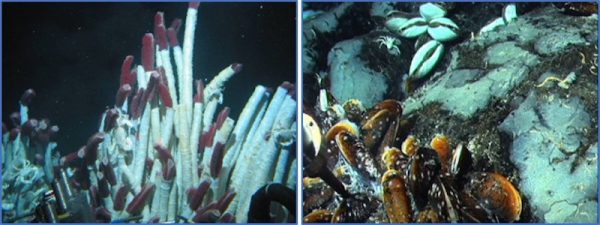
As in life and business, chemosynthetic symbiosis is all about relationships. In most cases, the larger organism is called the host, and the smaller one, Archaea in this case, is called the symbiont.
The large tube worms, for instance, harbor the Archaea in the place that would be their gut. Recent studies suggest that 60% – 70% of the worm mass is Archaea, meaning there are more Archaea than worm. Let that sink in a moment. But then recognize that the clams do a similar thing by making room for the Archaea in their gill area. Both hosts derive energy and nutrition from the molecules produced by their symbiont, and the symbiont gains a safe place to live with a predictable environment.
In the hydrothermal vent community, Archaea are the primary producers, just like phytoplankton are at the surface of the sea. They occupy the bottom of the food chain, and everything farther up the chain depends on them in one way or another. When everything goes as planned, all is well in one of the strangest neighborhoods on the planet. Spend a little time getting to know the inhabitants of deep vent communities and you will understand what motivates people like Bob Ballard to cross oceans and risk their lives in deep dark places just to get a glimpse of them.
Final Thoughts
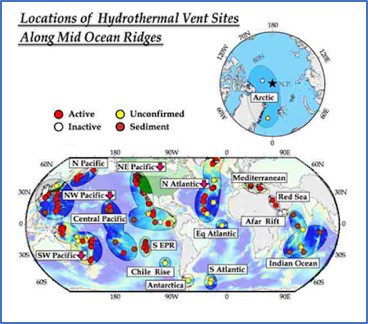
Since the monumental discoveries at the Galapagos Rift in 1977, scientists have found hundreds of vent sites around the world, each with its own collection of interesting and unique inhabitants. Although we’ve learned some amazing things about hydrothermal vents and the species that depend on them, we’ve barely gotten started because it’s risky and expensive to visit them and very challenging or impossible to simulate their environments in a laboratory.
The ongoing studies of hydrothermal vent communities are helping us better understand how life is organized down there, how long it may have existed, and how it deals with life’s day-to-day annoyances and challenges, which can include things like collapsing chimneys and vents opening and closing at the whim of tectonic forces. Scientists are even using genetic tools to determine whether the vent species truly are “living fossils,” as some people believe, or whether their evolution was influenced by the kinds of global environmental change experienced by their counterparts at the surface.
Probably the most important thing we have learned since 1977 is that many of our previous assumptions regarding the limits of life on earth were fundamentally wrong. In an article titled, “In Search of Heat: A Brief History of the Search for Hydrothermal Vents on the Deep Seafloor,” Dr. Kathleen Crane and Paula Keener-Chavis provide an excellent synopsis of vent discovery and the resulting scientific research. Dr. Crane, a key member of the 1977 Galapagos Rift team, points out how the discoveries there dispelled a long-held belief regarding deep-ocean life:
“For the first time, scientists understood that the deep sea was not devoid of life. Live clams over one foot long and orange animals that had never been seen before filled the view ports of the tiny submersible.”
You could consider the 1977 discovery a “we are not alone” moment… on our own planet.
Dr. Crane also observed that the cycling of water through deep-ocean vents contributes to making the ocean salty, along with runoff from the land. In addition, the warm-water vent plumes may be the driving force in deep-water ocean currents, which we’re only now beginning to understand. These discoveries suggest that even in regions of our planet that seem fundamentally disconnected from the surface, there are, in fact, connections.
Based on deep-hydrothermal vent discoveries, scientists are also revisiting their models and theories regarding the origins of life on earth and expanding these ideas to help us look for life on other worlds. If life on earth can exist in incredibly inhospitable places on the bottom of the ocean, it seems plausible it could exist on other worlds with similar environmental challenges. Recent evidence of hydrothermal vents on Saturn’s moon Enceladus, for instance, could be the next Galapagos Rift waiting for the next Bob Ballard. The idea that we already have living examples to study at the bottom of our oceans is both exciting and astounding.
It’s vitally important that we preserve these ecosystems and their strange (to us) inhabitants for future generations to study and appreciate–preferably from afar. Some of the rarest species in the world are found only in hydrothermal vents. At the Endeavor Hydrothermal Vent, for instance, 12 species that live there, including the sea spider Sericosura venticola featured at the beginning of this essay, have not been found anywhere else.
The ”Primordial Ooze” of Antarctica and the walking trees of the Amazon have nothing over these creatures that have evolved to survive in hot, chemically caustic conditions in complete darkness and under immense pressure. There is nothing like them anyplace else on earth.
In 2003, Canada became the first country in the world to create a marine-protected area for the hydrothermal vent community off the coast of Canada and Washington: the Endeavor Hydrothermal Vent Marine Protected Area. Sixteen years later, Pew Charitable Trust made a case for protecting hydrothermal vents and their inhabitants from potential deep-sea mining projects. Let’s hope this trend continues so places like Endeavour will always be there for future generations to study and appreciate.
Given Endeavour is basically in my backyard, maybe someday I’ll get to visit (if National Geographic calls).
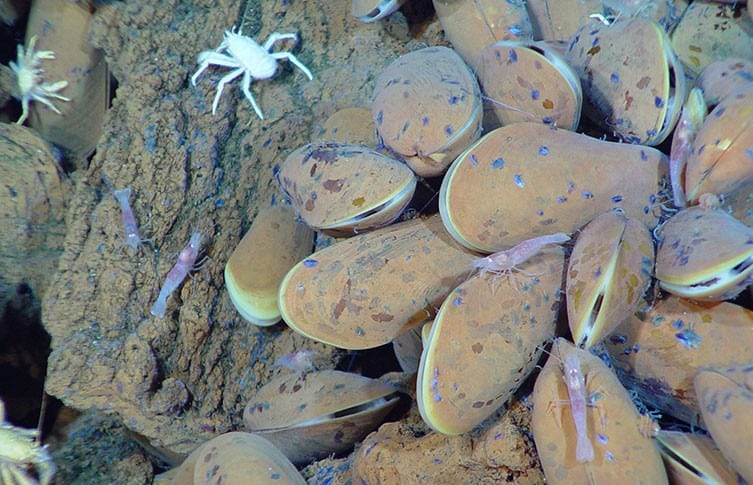
Information Sources
Introduction
Endeavour Hydrothermal Vents, Wikipedia.
A City of Geothermal Chimneys Discovered Off The Coast Of The US, IFLScience.com.
Hydrothermal Chimney Distribution on the Endeavour Segment, Juan de Fuca Ridge, David A. Clague et al., April 14, 2020, AGU Geochemistry, Geophysics, Geosystems.
Endeavour Segment of the Juan de Fuca Ridge- One of the Most Remarkable Places on Earth, Deborah S. Kelley et al., October 2, 2015, Oceanography 25(1); 44-61.
Endeavour Hydrothermal Vents, In Klinkenberg, Brian. (Editor) 2020, Biodiversity of British Columbia [www.biodiversity.bc.ca], Lab for Advanced Spatial Analysis, Department of Geography, University of British Columbia, Vancouver.
25 Things Hidden Deep Within the Amazon Forest That No One Knows About, The Travel.
Blood Falls Antarctica, Natural Time Capsule Containing an Alien Ecosystem., Atlas Obscura.
The Most Unique Ecosystems on Earth, Greentumble.com.
Hundreds of Hydrothermal Chimneys Discovered on the Seafloor off the Pacific Northwest, MBARI (Monterey Bay Aquarium and Research Institute, April 28, 2020.
Hydrothermal Vents: Survival at the Ocean’s Hot Springs, Emily Osterloff, Natural History Museum
A “Titanic” Discovery
Benchmarks: February 17, 1977: Hydrothermal Vents are Discovered, EARTH, The Science Behind the Headlines, EarthMagazine.org, Timothy Oleson, Sunday January 4, 2015.
The Deep-Sea Find That Changed Biology, National Public Radio, Forgotten Treasures of Science, Rebecca Davis and Christopher Joyce, December 5, 2011.
1972 – The Trail Gets Hot, Discovering Hydrothermal Vents, Dive and Discover, Woods Hole Oceanographic Institute.
1977 – Astounding Discoveries, Discovering Hydrothermal Vents, Dive and Discover, Woods Hole Oceanographic Institute.
The Most Influential Places in History, The Galapagos Rift, Tullis Onstott Time, April 23, 2012.
NOAA Photo Library, Vents and Seeps, National Oceanic and Atmospheric Administration.
Hydrothermal Vent Dynamics
Hydrothermal Vents, Teachers Notes, Dove Marine Laboratory, School of Marine Science and Technology, Newcastle University, United Kingdom.
Endeavour Segment of the Juan de Fuca Ridge- One of the Most Remarkable Places on Earth, Deborah S. Kelley et al., October 2, 2015, Oceanography 25(1); 44-61.
In Search of Heat: A Brief History of the Search for Hydrothermal Vents on the Deep Seafloor, Dr. Kathleen Crane, Ph.D., Program Manager, NOAA Arctic Research OfficeProfessor, Hunter College, CUNY; Paula Keener-Chavis, National Education Coordinator, NOAA Office of Ocean Exploration; Oceanexplorer.NOAA.gov.
Chemosynthesis
Sergei Winogradsky: A Founder of Modern Microbiology and the First Microbial Ecologist, Martin Dworkin and David Gutnick, FEMS Microbiology Reviews, Volume 36, Issue 2, March 2012, Pages 364–379.
Chemosynthesis, Wikipedia
The Alien Worlds of Hydrothermal Vents, Science in the News, Harvard University, May 31, 2013.
The Microbes That Keep Hydrothermal Vents Pumping, Smithsonian Ocean
Cutting Through the Smoke: The Diversity of Microorganisms in Deep-sea Hydrothermal Plumes, Anni Djurhuus et al., Royal Society Publishing, April 12, 2017.
Extending the Upper Temperature Limit for Life, Kazem Kashefi and Derek Lovley, Science.org, August 15, 2003.
Chemosynthetic Symbiosis
Deep-sea Tubeworms Get Versatile ‘Inside’ Help- Scientists Find First Known Organism That Makes Organic Carbon by Two Different Means, Kristen M. Kusek, Oceanus, Woods Hole Oceanographic Institution, January 12, 2007.
Host-Microbe Interactions in the Chemosynthetic Riftia pachyptila Symbiosis, Tjorven et al., American Society for Microbiology, December 17, 2019.
Chemosynthetic Symbioses, E. Maggie Sogin, et al., Current Biology Volume 30, Issue 19, 5 October 2020, Pages R1137-R1142, ScienceDirect.
Final Thoughts
Hydrothermal Vent Communities, Dr. Susan L. Woodward, Professor of Geography Emerita, Department of Geospatial Science, Radford University, Radford, Virginia
In Search of Heat: A Brief History of the Search for Hydrothermal Vents on the Deep Seafloor, Dr. Kathleen Crane, Ph.D., Program Manager, NOAA Arctic Research Office Professor, Hunter College, CUNY; Paula Keener-Chavis, National Education Coordinator, NOAA Office of Ocean Exploration; Oceanexplorer.NOAA.gov.
Deep-sea Vent Animals Not as Isolated as They Seem, Laura Poppick, March 29, 2013, Monterrey Bay Aquarium and Research Institute.
On the Instability and Evolutionary Age of Deep-sea Chemosynthetic Communities, See Vrijenhoek, R.C., (2013). Deep-Sea Research Part II: Topical Studies in Oceanography, DOI 10.1016/j.dsr2.2012.12.004 (published online in December 2012).
New Study Challenges Prevailing Theory About How Deep-sea Vents are Colonized, Kim Fulton-Bennett, Monterrey Bay Aquarium and Research Institute.
MBARI Scientist Uses Genetics to Study Hydrothermal Vent Animals, Monterrey Bay Aquarium and Research Institute, October 17, 2003
Hydrothermal Vents and the Origins of Life, Rachael Brazil, Chemistryworld.com.
Origin of Life: Did a Simple Pump Drive Process?. Tia Goese, LiveScience.com
Hydrothermal Activity, Jay Thompson, NASA Science, Solar System Exploration, April 12, 2017.
Deep-Sea Mining on Hydrothermal Vents Threatens Biodiversity- Protections could safeguard ecosystems that lie beyond national jurisdiction. PEW Charitable Trust Fact Sheet, September 26, 2019.
Endeavour Hydrothermal Vents Marine Protected Area (MPA), Government of Canada
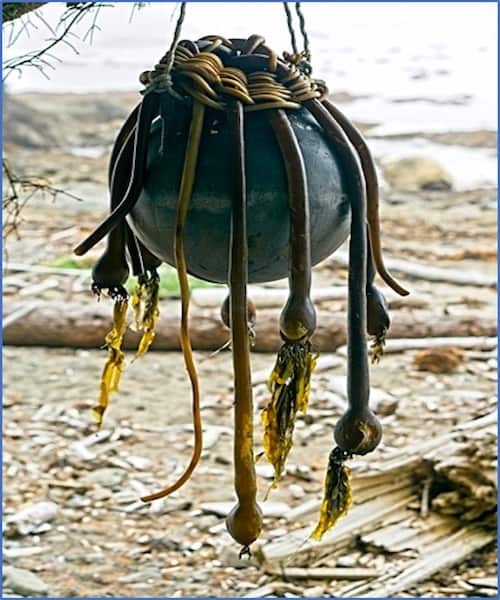
0 Comments